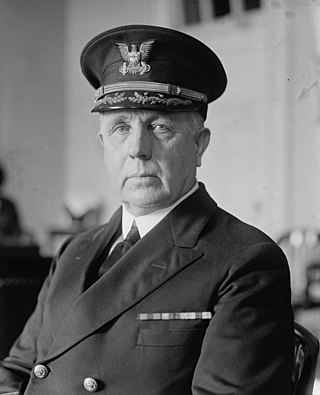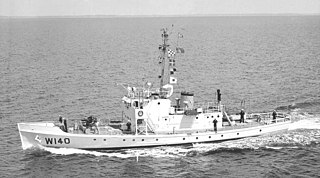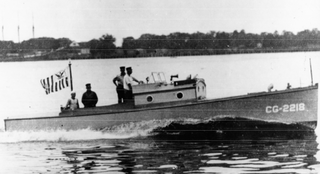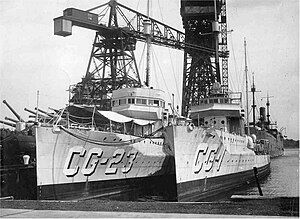
William Frederick "Bill" McCoy, was an American sea captain and rum-runner during the Prohibition in the United States. In pursuing the trade of smuggling alcohol from the Bahamas to the Eastern Seaboard, Capt. McCoy, found a role model in John Hancock of pre-revolutionary Boston and considered himself an "honest lawbreaker." McCoy took pride in the fact that he never paid a cent to organized crime, politicians, or law enforcement for protection. Unlike many operations that illegally produced and smuggled alcohol for consumption during Prohibition, McCoy sold his merchandise unadulterated, uncut and clean - therein becoming known as "The Real McCoy".

Joseph Francis Farley served as the ninth Commandant of the United States Coast Guard from 1946 to 1949. He was also the first Coast Guard officer to be issued a service number and held #1000 on the Coast Guard officer rolls.

Frederick Chamberlayne Billard served as the sixth commandant of the United States Coast Guard for an unprecedented three terms from 1924 until his death in 1932. Rear Admiral Billard died of pneumonia in May 1932 shortly after starting his third term. There were major changes to the organization during his career. The U.S. Revenue-Marine that was established on 4 August 1790 became the Revenue Cutter Service in 1894, the same year he enlisted. The Revenue Cutter Service that he had entered in 1894 merged with the United States Life-Saving Service to form the United States Coast Guard on 28 January 1915.

William Edward Reynolds served as the fifth Commandant of the United States Coast Guard, from 1919 to 1924.

Rum-running, or bootlegging, is the illegal business of smuggling alcoholic beverages where such transportation is forbidden by law. The term rum-running is more commonly applied to smuggling over water; bootlegging is applied to smuggling over land.

USCGC Tallapoosa (WPG-52) was a United States Coast Guard cutter of the Tallapoosa-class and was designed to replace the revenue cutter Winona. Her hull was reinforced for light icebreaking. She was initially stationed at Mobile, Alabama, with cruising grounds to Lake Pontchartrain, Louisiana, and Fowey Rocks, Florida. During World War I she escorted convoys out of Halifax, Nova Scotia. After the war she served with the Bering Sea Patrol before returning to Savannah, Georgia, before World War II. During the war Tallapoosa assisted with convoy escort duty and anti-submarine patrols.

USCGC General Greene (WPC/WSC/WMEC-140), was a 125 ft (38 m) United States Coast Guard Active-class patrol boat, in commission from 1927 to 1968 and the fourth cutter to bear the name of the famous Revolutionary War general, Nathanael Greene. She served during the Rum Patrol, World War II and into the 1960s performing defense, law enforcement, ice patrol, and search and rescue missions.

USCGC Marion (WSC-145), was a 125 ft (38 m) United States Coast Guard Active-class patrol boat in commission from 1927 to 1962. She was named for Francis Marion, an American Revolutionary War general who was known for his unconventional warfare tactics. Marion served during the Rum Patrol and World War II performing defense, law enforcement, ice patrol, and search and rescue missions. Most notably, Marion served as the platform for the first intensive oceanographic studies made by the Coast Guard.

USCGC Crawford (WSC-134), was a 125 ft (38 m) United States Coast Guard Active-class patrol boat in commission from 1927 to 1947. She was named for William H. Crawford, (1772–1834) who was appointed in 1816 as Secretary of the Treasury by President James Madison and he continued under President James Monroe through 1825. Crawford was the seventh vessel commissioned by the U.S. Revenue Cutter Service and the Coast Guard named after the former secretary. She served during the Rum Patrol and World War II performing defense, law enforcement, ice patrol, and search and rescue missions.

The United States Coast Guard wooden-hulled 75-foot patrol boats were built during Prohibition to help interdict alcohol smugglers. Their nickname was derived from the slang term "six bits" meaning 75 U.S. cents.

USS YP-16 was a wooden-hulled patrol vessel in commission in the fleet of the United States Coast Guard as CG-267 from 1925 to 1934, and in the fleet of the United States Navy as YP-16 from 1934 until 1941. She was sunk by Japanese aircraft during the Japanese attack on Guam.

USS YP-17 was a wooden-hulled patrol vessel in commission in the fleet of the United States Coast Guard as CG-275 from 1925 to 1933, and in the fleet of the United States Navy as YP-17 from 1933 until 1941. She was captured by Japanese forces during the Japanese attack on Guam.

USS YP-18 was a wooden-hulled patrol vessel in commission in the fleet of the United States Coast Guard as CG-263 from 1925 to 1934, and in the fleet of the United States Navy as YP-18 from 1934 until 1938.

USS YP-10 was a wooden-hulled patrol vessel in commission in the fleet of the United States Coast Guard as CG-194 from 1925 to 1934, and in the fleet of the United States Navy as YP-10 from 1934 until 1941.

USS YP-15 was a wooden-hulled patrol vessel in commission in the fleet of the United States Coast Guard as CG-149 from 1925 to 1933, and in the fleet of the United States Navy as YP-15 from 1933 until 1945.
CG-107 was a wooden-hulled patrol vessel in commission in the fleet of the United States Coast Guard.
CG-113 was a wooden-hulled patrol vessel in commission in the fleet of the United States Coast Guard.
CG-108 was a wooden-hulled patrol vessel in commission in the fleet of the United States Coast Guard.
CG-249 was a wooden-hulled patrol vessel in commission in the fleet of the United States Coast Guard.

The United States Coast Guard wooden-hulled 36-foot picket boats were built during Prohibition to help interdict alcohol smugglers.














